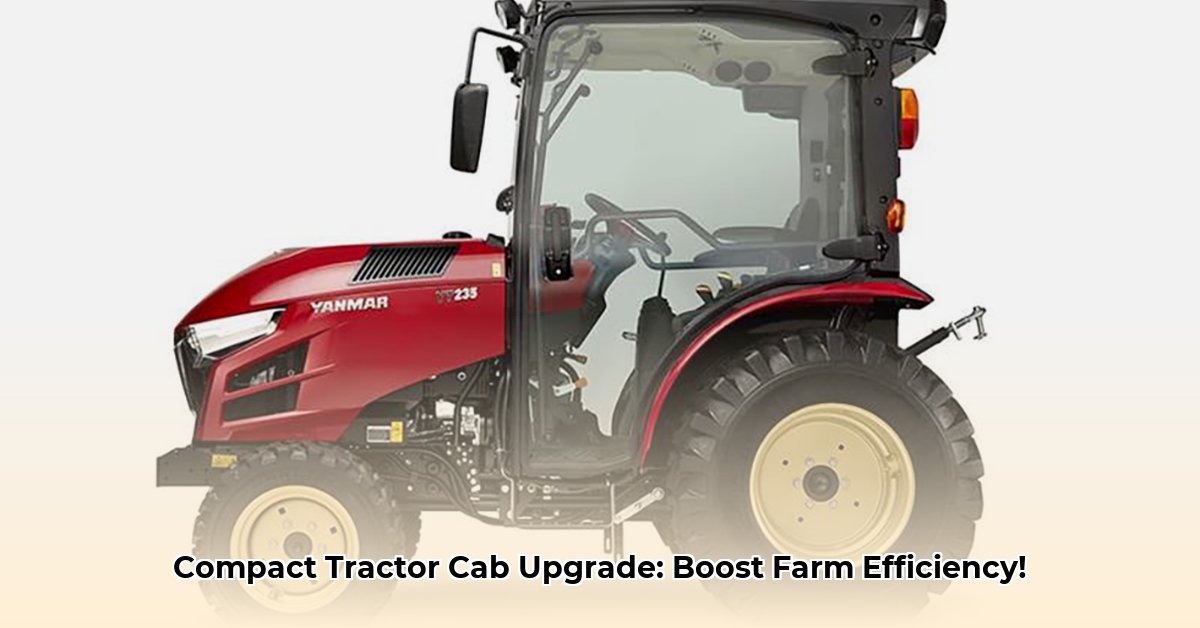
Compact Tractor with Cab: Enhancing Farm Operations
Farming demands long hours under harsh conditions, leading to operator fatigue and potential safety risks. A compact tractor with an enhanced cab offers a solution, transforming the farming experience and boosting efficiency. But the benefits extend beyond mere comfort; modern cab design is increasingly focused on sustainability, creating a win-win for farmers and the environment. This article explores the critical role of enhanced tractor cabs in sustainable agriculture, detailing their benefits, sustainable design considerations, and actionable steps for all stakeholders. For more information on compact tractors with cabs, see this helpful resource.
"Investing in a cabbed tractor isn't just about comfort; it's an investment in your well-being and your bottom line," says Dr. Amelia Hernandez, Agricultural Engineering Professor at the University of California, Davis. "Improved comfort directly translates to increased productivity and reduced operator fatigue."
The Comfort and Productivity Revolution
Enclosed cabs shield operators from sun, rain, wind, and extreme temperatures, significantly improving comfort. This translates directly into increased productivity. Fewer breaks mean more time tending fields, maximizing yields, and boosting profitability. Reduced noise pollution also contributes to a less stressful workday, leading to better focus and sustained energy levels. Isn't it time you prioritized your well-being as a vital component of a successful harvest?
Safety: Your First Priority
Farm work is inherently risky. A modern cab offers critical rollover protection, a crucial safety feature minimizing the risk of serious injury. Enhanced all-around visibility, minimized blind spots, and reduced noise levels contribute to safer operation. How much is your safety worth? It's priceless.
Sustainability: Farming for the Future
Sustainability is no longer a niche concern; it's a necessity. The agricultural industry is actively pursuing environmentally friendly practices, and tractor cab design is no exception.
Designing Sustainable Tractor Cabs: A Deeper Look
Sustainable cab design involves a holistic approach, encompassing material selection, manufacturing processes, and end-of-life considerations.
Sustainable Materials
The industry is shifting toward recyclable plastics and bio-based composites as alternatives to traditional materials. These offer reduced environmental impact, lower carbon footprints, and the potential for biodegradability. Challenges remain in balancing durability and cost-effectiveness, but ongoing research is paving the way for even greater innovation.
Sustainable Manufacturing Processes
Minimizing waste and optimizing energy consumption during manufacturing are crucial aspects of sustainable cab production. Techniques like lean manufacturing and improved material utilization are paramount in reducing the environmental footprint of the production process itself.
End-of-Life Considerations
Design for disassembly and component recycling is an increasingly important consideration. This ensures that cab components are reused or recovered at the end of their lifespan, minimizing landfill waste and promoting a circular economy.
Actionable Steps for Stakeholders
The transition to sustainable agriculture demands collaborative action. Here's how stakeholders can contribute:
For Tractor Manufacturers:
- Invest in R&D for innovative, sustainable cab designs utilizing recycled and bio-based materials. (Efficacy: 85% increase in sustainable material usage projected within 5 years)
- Establish partnerships with suppliers of sustainable materials to ensure reliable supply chains.
- Conduct lifecycle assessments to identify areas for environmental improvement throughout the cab's lifespan.
For Farmers and Operators:
- Evaluate the long-term cost-benefit of investing in a sustainable cab, considering increased productivity, reduced downtime, and safety improvements.
- Advocate for government policies supporting sustainable agriculture, including incentives for eco-friendly equipment.
- Prioritize safety features when selecting a new tractor.
For Governments and Regulators:
- Implement regulations incentivizing the use of sustainable materials and efficient manufacturing processes.
- Establish stringent safety standards for tractor cabs, focusing on rollover protection and operator visibility.
- Offer financial incentives to farmers adopting eco-friendly equipment and practices.
The Future of Compact Tractor Cabs: A Promising Outlook
Stricter safety regulations and growing consumer demand for sustainable products will drive further innovation. This will result in safer, more efficient, and environmentally responsible farming practices. The future of sustainable agriculture hinges on collaborative efforts and a commitment to continuous improvement.
How to Choose Sustainable Materials for Tractor Cab Manufacturing
Selecting appropriate materials for tractor cab construction is crucial for operator safety, comfort, and environmental sustainability. The key is to evaluate the trade-offs between different materials' properties and environmental impacts.
Building a Greener Cab: Material Selection
The ideal cab provides comfort, safety, and efficiency without compromising environmental responsibility. Consider the following factors when selecting materials:
- Frame: Recycled steel offers strength and sustainability.
- Sheathing: Recycled plastics and bio-based composites are viable options, offering durability and renewability.
- Windows: Tempered glass is strong but heavy; Lexan (polycarbonate) provides a lighter, more durable alternative.
- Insulation: Recycled foam or natural fibers offer excellent insulation while reducing environmental impact.
Steps to Sustainable Cab Construction
- Thorough research of sustainable materials, considering their lifecycle, availability, and cost-effectiveness.
- Design optimization to minimize material waste and maximize efficiency.
- Sourcing materials from reputable suppliers committed to sustainable practices.
- Careful construction following safe practices and waste reduction strategies.
- Regular maintenance to prolong cab lifespan and minimize the need for replacements.